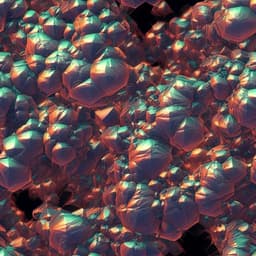
Engineering and Technology
A flexible electron-blocking interfacial shield for dendrite-free solid lithium metal batteries
H. Huo, J. Gao, et al.
Discover groundbreaking advancements in solid-state batteries with a novel electron-blocking interfacial shield designed to mitigate lithium dendrite formation. This innovative approach not only enhances lithiophilicity but also stabilizes lithium volume changes, leading to exceptional stability in cycling performance, as highlighted by the research conducted by Hanyu Huo, Jian Gao, Ning Zhao, Dongxing Zhang, Nathaniel Graham Holmes, Xiaona Li, Yipeng Sun, Jiamin Fu, Ruying Li, Xiangxin Guo, and Xueliang Sun.
~3 min • Beginner • English
Introduction
The study addresses a central challenge in garnet-based solid-state lithium metal batteries: lithium dendrite nucleation and propagation driven by electronic conduction through the electrolyte and exacerbated by poor Li/electrolyte interfacial contact and uneven electric-field distribution. The research question is whether a flexible, electron-blocking interfacial shield formed via an in-situ substitution reaction can simultaneously enhance lithiophilicity/wettability, block electron permeation into the garnet electrolyte, and accommodate Li volume changes to suppress dendrite growth. The work is important for realizing safe, high-energy-density SSBs by stabilizing the Li/garnet interface, raising the critical current density (CCD), and enabling long, room-temperature cycling.
Literature Review
Prior studies have shown that garnet electrolytes (e.g., LLZO/LLZTO) suffer from intergranular lithium penetration and electronic degradation, with high electronic conductivity implicated as a root cause of dendrite formation within solid electrolytes. Numerous interfacial engineering strategies have sought to reduce interfacial resistance and improve wettability, including alloy-forming metallic layers (e.g., Au), conversion reaction interlayers (e.g., SnO₂), and ionically conductive polymer layers (e.g., PEO-based layers), as well as Li₃N, Al₂O₃, graphite, and Cu–Sn–S frameworks. However, while improved wettability can reduce interfacial resistance, conductive interlayers can facilitate electron injection and accelerate electronic degradation, and polymer–salt layers can exhibit sluggish Li⁺ transport and low transference numbers, limiting CCD and cycle life. Comparative literature benchmarking (referenced in the article’s Fig. 4f) indicates that achieving high CCD at room temperature with garnet remains challenging, motivating an interfacial design that is both electron-blocking and mechanically compliant while maintaining fast Li⁺ transport.
Methodology
- Materials and interfacial layer formation: Ta-doped garnet Li₄La₃Zr₁.₄Ta₀.₆O₁₂ (LLZTO) powders were prepared by solid-state reaction; pellets were sintered via hot-pressing to a high relative density of 99.5 ± 0.5% (Archimedes). Poly(acrylic acid) (PAA, Mw ~450,000) was dissolved in DMSO (0.25 wt%) at 60 °C for 12 h. LLZTO@PAA was obtained by drip-casting onto LLZTO pellets followed by vacuum drying at 80 °C. The electron-blocking shield (EBS) was formed in situ by reacting the PAA-coated LLZTO with molten Li at 250 °C (LiPAA formation via substitution reaction).
- Characterization: XRD (Bruker D2 Phaser, Cu Kα, 2θ = 10–80°, step 0.02°) for phase analysis. SEM (S3400) for surface/cross-section morphology. TOF-SIMS IV with 25 keV Bi LMIS, base pressure 10⁻⁸ mbar; negative secondary ions; analysis area 334 × 334 µm²; depth profiling via Cs⁺ (3 keV) over 100 × 100 µm²; sputter rate 0.96 nm s⁻¹ on Si. AFM (Veeco Dimension V) to map Young’s modulus via 10 × 10 force maps over 10 × 10 µm²; analysis by SPIP. DEMS to detect H₂ release and confirm reaction mechanism. LiPAA structure/composition probed by SEM, XPS, FTIR, and Raman.
- Interface and dendrite analysis: For interface SEM, Li was melted on LLZTO at 250 °C for 30 min, cooled, and pellets fractured. For dendrite analysis, short-circuited cells were disassembled in Ar; Li removed by sanding; dark spots identified; pellets fractured at those sites for cross-sectional SEM along grain boundaries.
- DFT calculations: VASP with PAW and PBE-GGA; DFT-D2 dispersion correction. Models for PAA/Li (single-chain on Li(001) with 35 Å vacuum; innermost Li layer fixed), Li₂CO₃(001)/Li(001), and LLZO(110)/Li(001). Energy cutoff 520 eV; 1 × 1 × 1 k-point grid; relaxation convergence 1.0 × 10⁻⁵ eV (energy) and 0.01 eV Å⁻¹ (forces). Structures visualized with VESTA. Work of adhesion and contact angles computed from interfacial energies.
- Electrochemical testing: Ionic conductivity measured with Novocontrol analyzer (AC 10 mV, 0.1–20 MHz) using sputtered Au blocking electrodes. Symmetric Li/LLZTO@PAA(LiPAA)/Li cells assembled by melting Li on both pellet sides at 250 °C for 30 min in Ar and sealing in Swagelok-type cells; ~10 N cm⁻² stack pressure maintained by springs. EIS (Autolab) from 1 MHz to 0.1 Hz, 10 mV amplitude. DC polarization at 0.1 V for electronic conductivity estimation. CCD test: current density ramped from 0.1 to 1.5 mA cm⁻² with 0.1 mA cm⁻² h⁻¹ steps at 25 °C. Long-term galvanostatic cycling at 0.2, 0.5, and 1.0 mA cm⁻² with areal capacities of 0.1, 0.25, and 1.0 mAh cm⁻², respectively, at 25 °C. Comparative interlayers (Au, PEO) and lower-density LLZTO (96% relative density; σion = 5.4 × 10⁻⁴ S cm⁻¹ at 25 °C) tested under similar conditions. For PEO interlayers: thickness ~5 µm; EIS and cycling at 60 °C.
- Full cells: LFP composite cathode prepared with LiFePO₄:Super P:PVDF:ionic liquid (PY14TFSI with 0.3 M LiTFSI) at 8:1:1:6 wt ratio; coated on Al foil (active loading ~2 mg cm⁻²). Full solid-state cells with LLZTO or LLZTO@EBS and Li metal anode; ionic liquid used as wetting agent to enhance Li⁺ migration into composite cathode.
Key Findings
- Formation mechanism and mechanics: In-situ substitution reaction between PAA and molten Li at 250 °C produces a dehydrogenated LiPAA interphase, confirmed by DEMS (H₂ release). AFM shows reduced average Young’s modulus from 20.6 GPa (LLZTO) to 3.3 GPa (LLZTO@PAA), indicating a soft, flexible interface that relieves interfacial stress.
- Wettability and adhesion: DFT-calculated work of adhesion (Wad) on Li: dehydrogenated PAA/Li = 60.1 meV Å⁻²; LLZTO(110)/Li(001) = 58.0 meV Å⁻²; Li₂CO₃(001)/Li(001) = 16.5 meV Å⁻². Corresponding contact angles θ: ~0° (PAA/Li), 85.9° (LLZTO/Li), 132.7° (Li₂CO₃/Li), consistent with experimental observations of complete wetting on LLZTO@EBS and poor wetting on bare LLZTO.
- Electron-blocking: Electrostatic potential profiles and DOS indicate no barrier for electron transfer at LLZTO/Li and anomalous electron permeation at Li₂CO₃/Li, enabling electronic degradation and dendrites. At PAA/Li, the interfacial electrostatic potential is 1.92 eV lower than in the LiPAA polymer, confining electrons to the interfacial region; DOS shows the inner LiPAA layer remains insulating. DC polarization shows lower electronic conductivity for LLZTO@EBS vs bare LLZTO.
- Interfacial resistance and Li⁺ transport: At 25 °C, Li/LLZTO/Li interfacial resistance is 1104.3 Ω cm²; Li/LLZTO@EBS/Li interfacial resistance is 54.5 Ω cm². Activation energies (Arrhenius): 0.51 eV (LLZTO/Li) vs 0.38 eV (LLZTO@EBS/Li), indicating facilitated Li⁺ migration across EBS-modified interfaces.
- Critical current density (CCD): At 25 °C with 0.1 mA cm⁻² h⁻¹ steps, CCD increases from 0.2 mA cm⁻² (bare LLZTO; overpotential >1 V) to 1.2 mA cm⁻² (LLZTO@EBS), among the highest reported for garnet at room temperature.
- Cycling stability (symmetric cells): Bare LLZTO short-circuits within three cycles at 0.2 mA cm⁻² (0.1 mAh cm⁻²). LLZTO@EBS cycles >1000 h with ~46.1 mV overpotential at 0.2 mA cm⁻²; stable for 400 h at 0.5 mA cm⁻² (0.25 mAh cm⁻²); and 400 h at 1 mA cm⁻² (1 mAh cm⁻²), all at 25 °C. Post-cycling SEM: bare LLZTO shows dendrites along grain boundaries; LLZTO@EBS remains smooth with dendrite-free grain boundaries; overall resistance increases slightly (from ~209.1 to ~224.3 Ω cm²) after 1000 h without short circuit.
- Comparisons: Au interlayer greatly improves wettability and reduces interfacial resistance (~43.2 Ω cm²) but yields CCD ~0.7 mA cm⁻² and shorter cycle life (stable ~200 h at 0.5 mA cm⁻²), attributed to electron attack via a conductive interface. PEO interlayer (5 µm) has high interfacial resistance (683.2 Ω cm² at 60 °C), CCD 0.6 mA cm⁻², and short-circuits after ~50 h at 0.5 mA cm⁻² at 60 °C due to sluggish Li⁺ transport and low transference number. Lower-density LLZTO (96% relative) promotes dendrites; LLZTO(96%)@Au short-circuits after 18 h at 0.2 mA cm⁻², while LLZTO(96%)@EBS cycles stably for 150 h at 0.2 mA cm⁻².
- Full cells (LFP/LLZTO@EBS/Li): Reduced polarization versus bare LLZTO. Discharge capacities: 142.3 mAh g⁻¹ (0.1 C), 130.2 (0.2 C), 119.5 (0.5 C), 95.4 (1 C); capacity recovers to 142.5 mAh g⁻¹ upon returning to 0.1 C. Capacity retention: 82.8% after 300 cycles at 0.2 C and 83.1% after 200 cycles at 0.5 C at room temperature, outperforming cells with bare LLZTO, Au, or PEO interlayers.
Discussion
The electron-blocking interfacial shield (LiPAA) simultaneously addresses key interfacial failure modes in garnet SSBs. The dehydrogenation-driven LiPAA interphase exhibits strong adhesion and near-zero contact angle with Li, ensuring intimate contact and homogeneous current distribution that lowers interfacial resistance and activation energy for Li⁺ transport. DFT electrostatic potential and DOS analyses, corroborated by DC polarization, show that LiPAA effectively confines electrons at the immediate Li/interphase region, preventing electron injection into LLZTO that would otherwise trigger electronic degradation and internal Li plating along grain boundaries. The soft, low-modulus interphase accommodates Li volume changes, preserving interfacial integrity over prolonged cycling. Compared to Au (electronically conductive) and PEO (ionically resistive, low transference number) interlayers, the EBS uniquely combines electron-blocking with good Li⁺ transport and mechanical compliance, thereby elevating CCD to 1.2 mA cm⁻² and enabling long-term, room-temperature cycling without dendrite-induced short circuits. The approach also mitigates dendrite growth in lower-density LLZTO with more grain boundaries, highlighting its robustness.
Conclusion
A flexible, dehydrogenated LiPAA electron-blocking interfacial shield formed by in-situ reaction of PAA with molten Li at 250 °C on LLZTO garnet electrolytes markedly enhances Li wettability, reduces interfacial resistance (from 1104.3 to 54.5 Ω cm²), lowers interfacial activation energy (0.51 to 0.38 eV), blocks electron penetration into the electrolyte, and accommodates Li volume change. As a result, symmetric cells achieve a room-temperature CCD of 1.2 mA cm⁻² and stable cycling for over 1000 h at 0.2 mA cm⁻² and 400 h at 1 mA cm⁻², while full cells with LFP cathodes show high capacities and strong rate/cycling performance. The EBS outperforms conductive (Au) and conventional polymer (PEO) interlayers by preventing electronic degradation and maintaining interfacial contact. Potential future directions include exploring other acidic polymer chemistries and molecular structures that undergo favorable substitution reactions with Li to form electron-blocking yet Li⁺-permeable interphases, and extending this strategy to other solid electrolytes and cathode architectures.
Limitations
- Formation of the EBS relies on reacting PAA with molten Li at 250 °C, which may impose processing constraints for certain cell designs or materials.
- The beneficial effect is polymer-chemistry dependent: attempts to form a similar interphase from PEO increased interfacial resistance and degraded performance, indicating limited transferability to non-acidic polymers.
- Full-cell demonstrations used an ionic liquid wetting agent to facilitate Li⁺ transport in the composite cathode at room temperature, which may influence practical implementation and comparisons.
Related Publications
Explore these studies to deepen your understanding of the subject.







